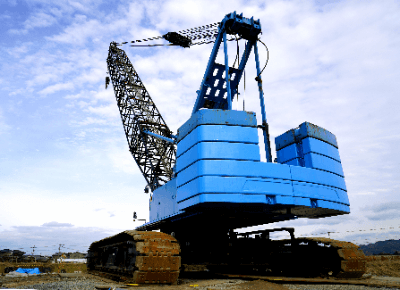What Is a Crawler Crane?
 A Crawler Crane is a crane that can travel on an infinite track called a crawler.
A Crawler Crane is a crane that can travel on an infinite track called a crawler.
It can move to the lifting location by itself and perform the work. Compared to wheel cranes that travel on tires, crawler cranes have a larger footprint and lower ground contact pressure, allowing them to be used on uneven ground or soft ground.
It also has the advantage of having the same lifting capacity in all directions around its circumference. On the other hand, since these cranes cannot be driven on public roads, they must be loaded on trailers for transportation, and cranes over a certain size must be disassembled for transportation.
Uses of Crawler Cranes
Crawler Cranes are often used in industries and workplaces that require lifting large, heavy materials over a wide work area, such as port construction, plant construction, wind power plant construction, etc.
Smaller cranes (less than 5 tons) are called mini Crawler Cranes and are often used for narrow road construction, stone and garden construction, etc. They are often used for narrow road construction, stone and garden work, etc.
The footprint of a Crawler Crane is large, and it has a large lifting capacity among mobile cranes. Lifting capacities range from as small as 0.5 tons to as large as 500 tons and up to the 3,000-ton class. Furthermore, the crane itself is equipped with a prime mover (mainly a diesel engine), enabling it to be self-propelled at the work site.
Principle of Crawler Cranes
A Crawler Crane consists of a traveling section, a crane body, and a tower.
1. Traveling Section
The traveling section consists of a grounding member called a crawler shoe, a driving unit such as a traveling motor, and driving rollers and sliding rollers. A traveling motor is installed in each of the left and right crawler shoes.
The traveling motors are often of the hydraulic type because they require high output power, and can move forward and backward by switching the oil flow path. The hydraulic pump is located in the crane body at the top and feeds oil to the traveling section at the bottom through a rotating joint called a swivel joint or rotary joint. The traveling section supports and moves the weight of the lifting members and the upper crane body.
2. Crane Body
The main body of the crane includes the base of the tower, operating equipment, control room, engine, hydraulic pumps, and slewing gear.
The crane body and the tower section are supported by large bearings on the traveling section and can swivel freely. The slewing gear on the crane body side is driven by a slewing motor. The inner gear of the ring body is fixed to the traveling section side. Rotation of the slewing gear on the main body side causes the crane body to slew, since the gear on the traveling section side that is engaged is fixed.
The crane uses a wire rope to lift the material, and the wire rope winding drum, winding motor, reduction gear, safety devices, etc. are equipped on the crane body.
3. Tower Section
The tower section consists of various parts, including the boom, which is the arm of the crane, and the hooks and wire ropes used to hoist the components.
Fixed-length lattice booms are used on large cranes. Products with telescopic booms that can be extended and retracted using hydraulic cylinders are on the rise.